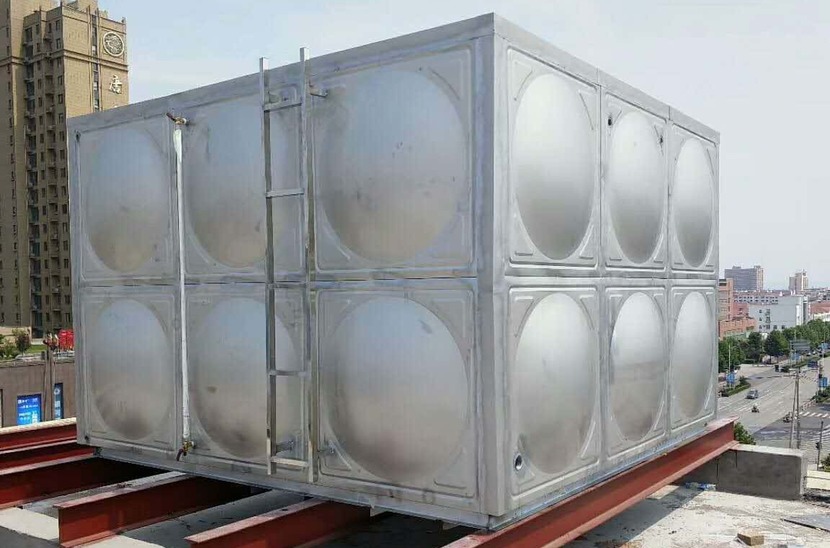Address: DeZhou,ShanDong,China | WhatsApp: +86-15098941090 | E-mail: support@aikegroupco.com

From the literal meaning, we can know that there must be differences in the materials of galvanized steel water tanks and stainless steel water tanks, but most people don’t know much about the two, and they don’t know where the difference is. So, today I will introduce to you the differences between galvanized steel water tanks and stainless steel water tanks.
Galvanized steel water tank: It uses galvanized steel plate as raw material, immerses the thin steel plate in the molten zinc pool, and adheres a thin layer of zinc on the surface. It is mostly produced by continuous galvanizing process, and the whole roll of steel plate is continuously immersed in the galvanizing tank to form a galvanized plate. There are also a variety of materials to choose from, such as: electro-galvanized steel plate, alloyed galvanized steel plate, composite galvanized steel plate, and single-sided and double-sided galvanized steel plate.
Stainless steel water tank: It is made of stainless steel plate. Common stainless steel plates include 201 stainless steel and 304 stainless steel. Among them, 304 stainless steel is a water tank plate that can store domestic water. It meets the standards for food use, has stable physical and chemical properties, and is resistant to most acidic substances and alkali solutions.
Because the galvanized layer of the galvanized steel plate water tank will be constantly worn during long-term use, and due to the erosion of moisture, acid and alkali in the environment, its service life is generally about 5-10 years. The service life of a stainless steel water tank can be more than 50 years because it is not affected by corrosion and rust.
The material of the stainless steel water tank makes it have excellent corrosion resistance, is not easily corroded by acids, alkalis, salts and other substances, and can adapt to various harsh environmental conditions. Although the galvanized layer of the galvanized steel plate water tank can play a certain anti-corrosion role, its anti-corrosion performance may be affected in some harsh environments, such as high temperature, high humidity, acidic soil, etc.
Stainless steel water tanks are made of food-grade stainless steel materials, which will not produce harmful substances. At the same time, they have good strength and sealing performance, and will not leak or deform. Galvanized steel water tanks may rust due to zinc wear during use, affecting their safety performance.
Due to the high material and processing costs of stainless steel, the price of stainless steel water tanks is generally higher than that of galvanized steel water tanks.
Galvanized steel water tank: After the zinc on the surface of the galvanized steel plate is oxidized, a dense zinc oxide film will be generated to isolate air and water vapor to prevent corrosion and rust, but it is not recommended to store domestic water. The corrosion resistance is general and does not meet the standards for food use.
Stainless steel water tank: Made of food-grade 304 stainless steel, the dense oxide layer on the surface can resist the erosion of chlorine molecules in the air and water, has good corrosion resistance, and has no secondary pollution to the water quality. The water quality will not cause harm to the human body if it is stored for a long time, and the water quality can be kept clean for a long time, with a higher hygiene coefficient.
Galvanized steel plate water tank: assembled with bolts, and sealing strips are used during assembly to reduce the occurrence of corrosion, rust, water seepage and other problems caused by improper welding at the weld.
Stainless steel water tank: There are two installation methods: assembled and combined. It can be assembled by welding or bolts. There are various installation methods, fast installation speed, no restrictions on the site, high flexibility, and the volume of the water tank can be increased or decreased at will.
Galvanized steel plate water tank: Galvanized water tanks have the characteristics of high temperature resistance, impact resistance, corrosion resistance, high strength, and not easy to deform. They can store hot water in bathing centers and hot springs, as well as temporary water storage tanks for building water supply storage, construction, industry, fire protection, geological surveys, etc.
Stainless steel water tank: 304 stainless steel plate can store drinking water, reduce the water supply pressure of urban pipe networks, and the problem of insufficient water supply in water plants. It is used more frequently in high-rise residential buildings, schools, etc. In industry, due to the corrosion resistance of stainless steel plates, it can be used to store chemical solutions.
The above is the difference between galvanized steel water tank and stainless steel water tank. I hope it will be helpful to you!